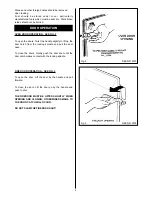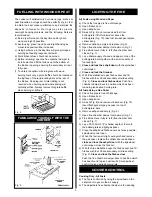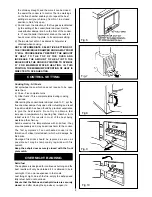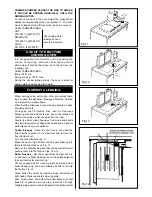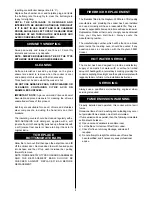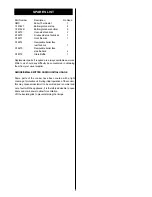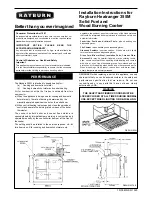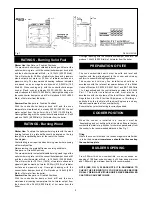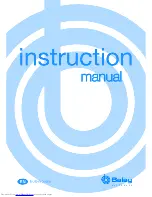
quarter of a turn.
Set the boiler thermostat knob to its minimum setting and
close the flue chamber damper plate to No. 1 setting. Set
the cooker/boiler chamber knob to ‘C’ to obtain optimum
heat into oven and hot plate.
NOTE: THE BEST POSITION FOR THE FLUE
CHAMBER DAMPER CAN BE FOUND ONLY BY
EXPERIMENT BUT ALWAYS TRY THE LOW SETTING
FIRST.
In the morning, open the spinwheel three complete turns,
the flue chamber damper to maximum and riddle the fire.
When it is burning brightly, close the flue chamber
damper, but do not refuel before use if the hotplate is
required immediately.
All Fuels.
Set the cooker/boiler damper knob ‘H’.
Close spinwheel.
To regulate burning, set the boiler thermostat knob to ‘8’
(high) or minimum rate ‘1’ (low).
Adjust as required to suit desired water heating.
Overnight banking and daytime slow burning should be
obtained with the boiler thermostat knob set at ‘1’ to give
extended burning.
Woodburning
Some wood are more difficult to burn therefore it may be
necessary to open the spinwheel in addition to the
thermostat to obtain the desired results. The spinwheel
must be closed as appropriate.
Solid Fuel
The appliance may be operated overnight for the
purpose of selected central heating when inclement
weather conditions occur.
Set the cooker/boiler damper knob to ‘H’ after refuelling
etc. and the boiler thermostat knob to No. 2 with the flue
chamber damper set at minimum. The spinwheel should
be closed and about four radiators can be run overnight
under these conditions.
NOTE: THE HOTPLATE AND OVEN TEMPERATURE
WILL BE CONSIDERABLY LOWER AND EXTENDED
TIME WILL BE NEEDED TO HEAT UP THESE
FEATURES. DO NOT FORGET TO RE-SET THE
COOKER/BOILER KNOB TO ‘C’ FOR COOKING
AFTER OVERNIGHT USE.
Wood
The appliance is designed for continuous slumbering
overnight for up to a maximum of 12 hours depending on
the type of dry wood being used. Last thing at night, open
the flue chamber damper. de-ash the fire, empty the
ashpan and fully refuel.
Ensure that the firebox and ashpit door are securely
closed
, close the spinwheel tight and the flue chamber
damper is set to No.1.
Set the boiler thermostat knob to its minimum setting
and the front damper knob to ‘c’.
Turn the flue dilution lever (See Fig. 7) from left to right
hand so that the flue chamber door opens at the bottom
and minimise burning rates.
NOTE: THE PRECISE AMOUNT OF OPENING
DEPENDS ON THE CHIMNEY DRAUGHT, THE
TYPE/CONDITION OF WOOD TO BE BURNT AND
THIS MAY TAKE 2 OR 3 DAYS TO ASCERTAIN
.
1. If the fuel in the firebox is exhausted prematurely, the
overnight chimney draught must be reduced by
increasing the opening setting of the flue chamber
door, using the flue dilution lever.
2. If the fuel does not burn but ‘dies out, the draught
should be increased by reducing the opening setting.
of the flue chamber door, using the flue dilution lever.
Following overnight banking, the flue chamber door must
be closed, the spinwheel and flue chamber damper
opened and the fire refuelled.
Immediately the new fuel has caught alight, riddle the fire
and close the flue chamber damper.
NOTE: BUILD-UP OF CREOSOTE DEPOSITS IN THE
FLUE AND CHIMNEY CAN IN TIME, LEAD TO
CHIMNEY FIRE.
THESE DEPOSITS CAN BE PREVENTED BY THE
REGULAR USE OF A PROPRIETARY BRAND OF
CHEMICAL CREOSOTE REMOVE CHIMNEY
CLEANER SUCH AS “ATTACK” WHICH REDUCES
THE ADHESION STRENGTH OF THE CREOSOTE
DEPOSITS, CAUSING THEM TO FAIL.
IMPORTANT: CHEMICAL CLEANERS MUST NOT BE
CONSIDERED AS AN ALTERNATIVE TO CHIMNEY
SWEEPING, ONLY AS SUPPLEMENTARY.
Against Thermostat knob settings with Cooker/Boiler
Damper at ‘H’ and Spinwheel closed.
Thermostat Setting No.
Water Temperature
(APPROXIMATE)
1
46ÞC (115ºF)
3
54.5ÞC (130ºF)
5
65.5ÞC (150ºF)
8
80ÞC (176ºF)
a) Using the cooker boiler to provide heat for domestic
hot water and radiators in the winter, a boiler thermostat
setting at No.8 is recommended.
b) Using the cooker boiler for the provision of domestic
hot water only, in the summer, a boiler thermostat setting
of No. 5 is recommended.
NOTE: TO CONSERVE FUEL, ENSURE THE HOT
WATER CYLINDER AND PIPES ARE LAGGED WITH
INSULATION.
BOILER CENTRAL HEATING
THERMOSTAT SETTING
OVERNIGHT CENTRAL HEATING
TYPICAL WATER
TEMPERATURES
OVERNIGHT BANKING
5



